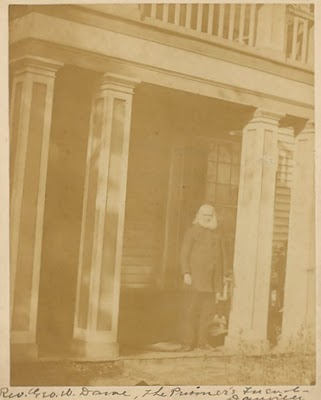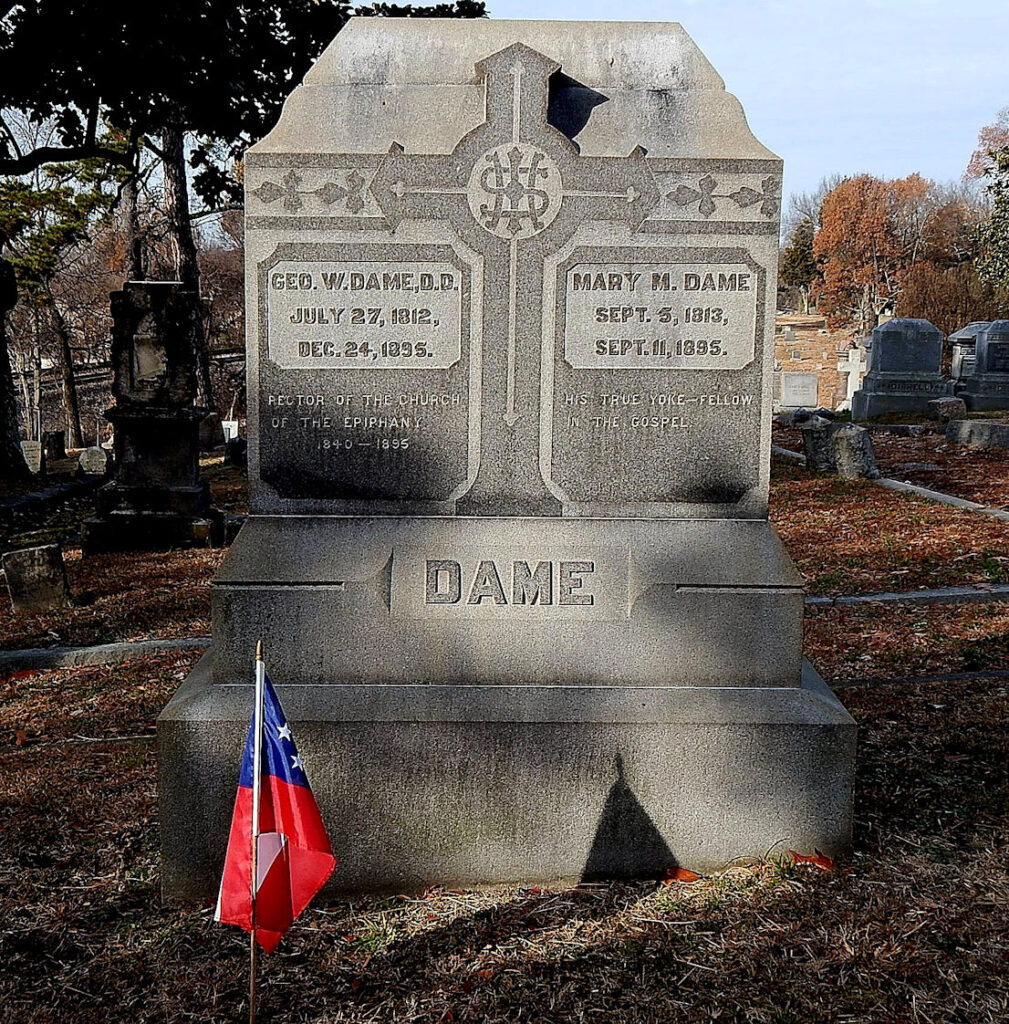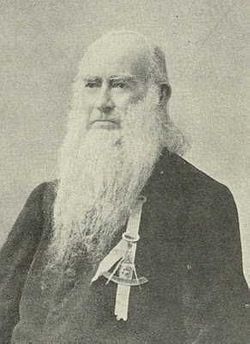George Washington Dame was born July 12, 1812 in Rochester, New Hampshire to Jabez and Elizabeth Hanson Cushing Dame. Both families where native to New Hampshire.
Dame came to Virginia in 1823, at the age of eleven, to live with his mother’s brother, Jonathan Peter Cushing, who was then sitting president of Hampden-Sydney College in Farmville. George stayed after his early education, and entered the college for himself, graduating with a Bachelor of Arts in natural science. In 1831, he left Virginia and attended medical school at the University of Pennsylvania but returned to Hampden-Sydney when his uncle fell ill. He received a Master of Arts degree in 1832 and the following year joined the school’s faculty. In 1834, he was appointed chair of geology and mineralogy and a professor of natural philosophy and chemistry.
While in Cumberland County in 1835, he met and married Mary Maria Page. A year later, after contracting tuberculosis, he left Hampden-Sydney to recuperate at the home of his wife’s parents. Upon regaining enough of his health that he felt he could work again (he never recovered entirely), he accepted a position as principal of a girls’ school in Lynchburg. By 1840, he had returned once more to Farmville where he took a position as head of a private academy in Prince Edward County.
It was during his convalescence that Dame became a member of the Episcopal Church, and through its influence he adopted the conviction that he was meant to enter the ministry. While working during the day operating a school for girls in Lynchburg in 1838, and then at Prince Edward Court House the following year, he spent his evenings preparing to enter the ministry. He was ordained a priest in August of 1841.
A year prior, in the summer of 1840, while engaged at the school at Prince Edward Court House, Dame accompanied a friend, Rev. James T. Clarke of Halifax County, to a funeral in Pittsylvania County. The journey took him through Danville. On the return trip, he stopped and met with the Board of Trustees of the Danville Female Academy which had been chartered in 1831 and whose premises were located on the corner of Loyal and Jefferson Streets. He was offered a position, which he initially declined, but by the fall, and having been petitioned a second time, he at last made up his mind to leave the floundering school in Prince Edward County, and relocated to Danville.
 Dame arrived in a Danville made up of about 500 residents, only four of whom were practicing Episcopalians. Mrs. Susan Poindexter, Mrs. George Welsh, Mrs. John Noble and Miss Sarah Noble, combined with the students of the Danville Female Academy made up the city’s first Episcopal congregation which met at the Academy. When A.Y. Stokes and E.J. Collins joined them in 1843, the congregation acquired the legal and financial status to purchase a lot of land in order to construct a proper edifice. The first lot purchased, and which was not developed, was that across from the Presbyterian Church at 200 Jefferson Avenue. The lot was later exchanged for its current location on the corner of Main Street and Jefferson Avenue.
Dame arrived in a Danville made up of about 500 residents, only four of whom were practicing Episcopalians. Mrs. Susan Poindexter, Mrs. George Welsh, Mrs. John Noble and Miss Sarah Noble, combined with the students of the Danville Female Academy made up the city’s first Episcopal congregation which met at the Academy. When A.Y. Stokes and E.J. Collins joined them in 1843, the congregation acquired the legal and financial status to purchase a lot of land in order to construct a proper edifice. The first lot purchased, and which was not developed, was that across from the Presbyterian Church at 200 Jefferson Avenue. The lot was later exchanged for its current location on the corner of Main Street and Jefferson Avenue.
The first building erected was a frame one, and it stood until 1879 when it was razed to construct a larger building. By 1885, just four years after the construction of the new building, the congregation numbered at 265 members.
Dame’s efforts to build up the Episcopalian Church were not confined to the city of Danville, however. When he arrived here in 1840, he agreed to serve the rector of Camden Parish, which included Franklin, Henry, Patrick, and Pittsylvania counties. Despite the geographic size of the parish, it consisted of a mere eight congregants. Dame was known to have traveled a hundred miles or more each month in his duties to that parish which included holding services in Chatham, Martinsville, and Rocky Mount. During his tenure, which spanned fifty-five years of service, he established ten churches with a total attendance of over 500 members.
During the Civil War, Dame ministered to the Union prisoners and to the wounded, Confederate and Union alike, who inhabited the prisons and prison hospitals here in Danville and received a commission as chaplain of the general hospital in June of 1864.
 The Danville Female Academy closed in 1865. In 1870, he was appointed the first superintendent of schools for Pittsylvania County, a position that made him responsible for examining and licensing teachers, supervising school boards, and overseeing the management of each school in the district.
The Danville Female Academy closed in 1865. In 1870, he was appointed the first superintendent of schools for Pittsylvania County, a position that made him responsible for examining and licensing teachers, supervising school boards, and overseeing the management of each school in the district.
In 1891, Hampden-Sydney College awarded Dame an honorary Doctorate of Divinity. Dame retired as rector of Camden Parish and of the Church of the Epiphany in 1894. He died at his home on Colquhoun Street on Christmas Eve 1895.
Sources:
“Houses of Horror: Danville’s Civil War Prisons” James I. Robertson, Jr. The Virginia Magazine of History and Biography, Vol. 69, No. 3. July 1961
Danville’s Civil War Prisons, 1863-1865. Karen Lynn Byrne. Virginia Polytechnic Institute and State University. 27 May 1993
If Streets Could Talk, Lee Wayland

Have you been to his graveside? I’d like to visit it the next time I’m there